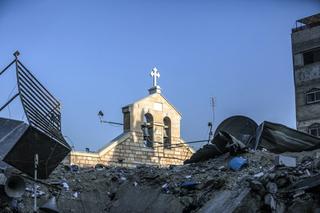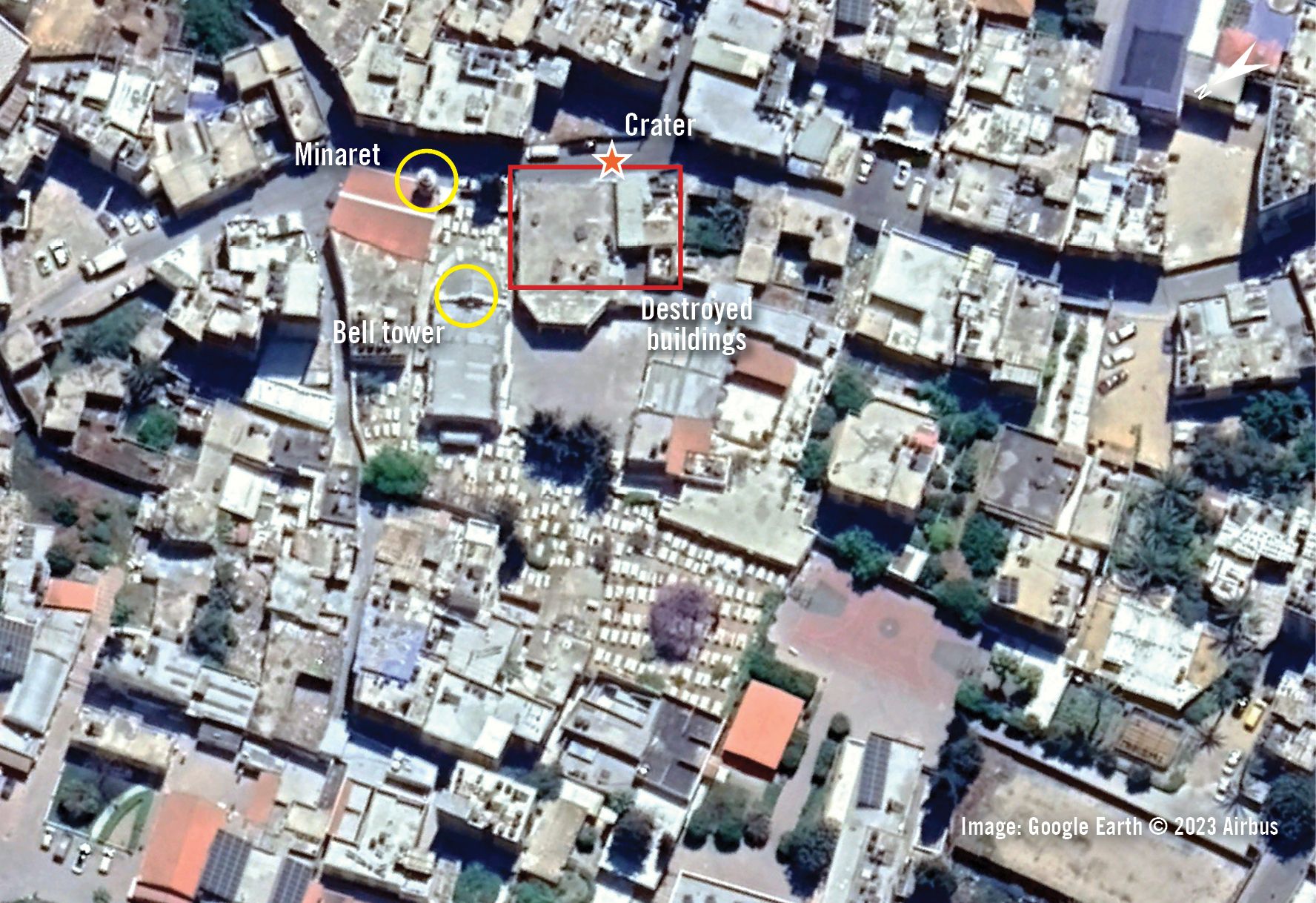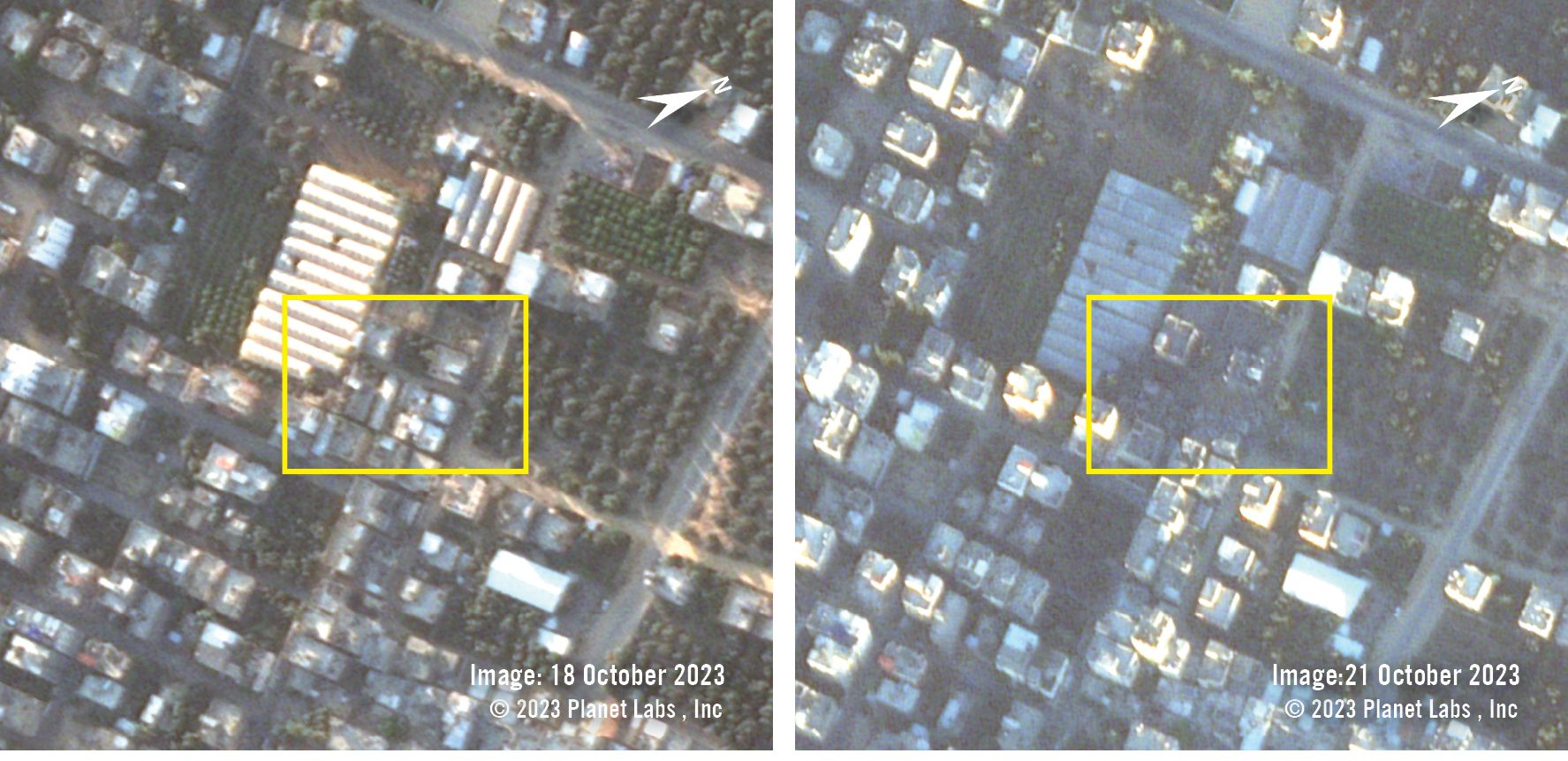Unlawful Israeli strikes illustrate callous disregard for Palestinian lives

Photo by Ali Jadallah/Anadolu via Getty Images
‘Nowhere safe in Gaza’: Unlawful Israeli strikes illustrate callous disregard for Palestinian lives
Press release
20 November 2023
Israeli forces have demonstrated – yet again – a chilling indifference to the catastrophic toll on civilians of their ongoing relentless bombardment of the occupied Gaza Strip.
As part of its ongoing investigation into violations of the laws of war, Amnesty International has documented two illustrative cases in which Israeli strikes killed 46 civilians, including 20 children. The oldest victim was an 80-year-old woman and the youngest was a three-month-old baby. These attacks must be investigated as war crimes.
The attacks, which occurred on 19 and 20 October, hit a church building where hundreds of displaced civilians were sheltering in Gaza City and a home in al-Nuseirat refugee camp in central Gaza.
Amnesty International, based on its in-depth investigation of these events, has determined that these strikes were indiscriminate attacks or direct attacks on civilians or civilian objects, which must be investigated as war crimes.
“These deadly, unlawful attacks are part of a documented pattern of disregard for Palestinian civilians, and demonstrate the devastating impact of the Israeli military’s unprecedented onslaught has left nowhere safe in Gaza, regardless of where civilians live or seek shelter,” said Erika Guevara-Rosas, Amnesty International’s Director of Global Research, Advocacy and Policy.
“We urge the International Criminal Court’s prosecutor to take immediate concrete action to expedite the investigation into war crimes and other crimes under international law opened in 2021.
“The harrowing accounts from survivors and relatives of victims describing the devastating human toll of these bombardments offer a snapshot of the mass civilian suffering being inflicted daily across Gaza by the Israeli military’s relentless attacks, underscoring the urgent need for an immediate ceasefire.”
Amnesty International visited the sites of the strikes, took pictures of the aftermath of each attack, and interviewed a total of 14 individuals, including nine survivors, two other witnesses, a relative of victims and two church leaders. Amnesty International’s Crisis Evidence Lab analysed satellite imagery and open-source audio-visual material to geolocate and verify the attacks.
The organization also reviewed relevant statements by the Israeli military and sent questions to the Israeli military’s spokesperson unit on 30 October regarding the church attack and the al-Nuseirat camp attack. At the time of publication, no response had been received.
Israeli authorities have not published any credible evidence of the basis for these strikes, including about alleged military objectives present. On the contrary, in the case of the bombing of the church building, the Israeli military published contradictory information, including a video it later withdrew and a statement it failed to substantiate. Amnesty International’s research did not find any indication that the buildings hit could be considered military objectives or were used by fighters.
These findings build on previous Amnesty International documentation of unlawful Israeli strikes during the current escalation and on documentation of a similar pattern of unlawful strikes during previous rounds of Israeli operations in Gaza. The current bombardment is unparalleled for Gaza in its intensity, in the number of civilians killed, and in the level of destruction to homes, schools, hospitals, and other civilian infrastructure.
“Israeli forces’ callous disregard for international humanitarian law has been documented by the organization extensively in previous military operations – but the intensity and cruelty of the current bombardment is unparalleled,” said Erika Guevara-Rosas.
“The horrifying death toll in Gaza – with more than 11,000 Palestinians killed, including more than 4,600 children within just six weeks – is in itself a signal of just how disposable Palestinian lives are in the eyes of Israeli forces ordering and carrying out these attacks.”
‘My heart died with my children’
On 19 October, an Israeli air strike destroyed a building in the compound of the Saint Porphyrius Greek Orthodox Church in the heart of Gaza’s old city, where an estimated 450 internally displaced members of Gaza’s small Christian community were sheltering. The strike killed 18 civilians and injured at least 12 others.
Ramez al-Sury, who lost his three children and 10 other relatives in the attack, told Amnesty International: “My heart died with my children that evening. All my children were killed: Majid, 11, Julie, 12, and Suhail, 14. I have nothing left. I should have died with my children.
“I left them only two minutes earlier. My sister called me to go downstairs to the basement to help my father [who is] bedridden since he had a stroke… my children stayed in the room with my cousins and their wives and children. That is when the strike happened and killed everyone.
“We left our homes and came to stay at the church because we thought we would be protected here. We have nowhere else to go… The church was full of peaceful people, only peaceful people… There is nowhere safe in Gaza during this war. Bombardments everywhere, day and night. Every day, more and more civilians are killed. We pray for peace, but our hearts are broken.”
Sami Tarazi told Amnesty International that his parents, Marwan and Nahed, were killed, along with his six-month-old niece, Joelle, and his 80-year-old relative, Elaine.
One of the church leaders told Amnesty International: “We don’t know why this bombardment [was launched] against our church; nobody has provided any explanation for causing such a tragedy. This is a church, a place of peace and love and prayer… There is no safety anywhere in Gaza at present.”
On 20 October, the Israeli military posted a video of drone footage on social media, reviewed and archived by Amnesty International, showing the moment of the air strike on a building within the church compound. Several media outlets then quoted an Israeli military statement indicating that “IDF fighter jets struck the command and control center belonging to a Hamas terrorist involved in the launching of rockets and mortars toward Israel”, acknowledging that “a wall of a church in the area was damaged” as a result of the strike, and assuring that “the incident is under review”.
However, the Israeli military video showing the strike has since been deleted, and no information has been provided by the Israeli military or authorities to substantiate the claim that the destroyed church building was a Hamas “command and control center”, nor any further information about the purported review of the strike.

This image shoes the location of the strike on the Saint Porphyrius Greek Orthodox Church compound in Gaza City. The map shows the estimated area affected (in red) caused by the Israeli army strike.
Amnesty International’s Crisis Evidence Lab examined, verified and geolocated videos and images posted on social media of the immediate aftermath of the strike, and analyzed satellite images of the location before and after the strike – all confirming the destruction of one building and partial destruction of another in the church compound.
Amnesty International’s weapons expert also examined the military’s video and other images, and concluded that a large air-delivered munition directly struck the building where those killed and injured were sheltering.
Church officials had publicly stated that hundreds of civilians were sheltering there prior to the strike, so their presence would therefore have been known to the Israeli military. The Israeli military’s decision to go ahead with a strike on a known church compound and site for displaced civilians was reckless and therefore amounts to a war crime, even if there was a belief that there was a military objective nearby.
‘I will live with that guilt for the rest of my life’
On 20 October at around 2pm local time, 28 civilians – including 12 children – were killed by an Israeli strike, which destroyed the al-Aydi family home and severely damaged two neighbouring houses in the al-Nuseirat refugee camp, in the central Gaza Strip, within the area where the Israeli military had ordered residents of northern Gaza to move to.
Rami al-Aydi, his wife Ranin, and their three children – Ghina, 10, Maya, eight, and Iyad, six – were killed. Zeina Abu Shehada and her two children, Amir al-Aydi, four, and Rakan al-Aydi, three, were also killed, along with Zeina’s two sisters and mother.
Hani al-Aydi, who survived the strike, told Amnesty International: “We were sitting at home, it was full of people, of children, of relatives. Suddenly, without any warning, everything collapsed on our head. All my brothers died, my nephews, my nieces… My mother died, my sisters died, our home is gone… There is nothing here, and now we are left with nothing and are displaced. I don’t know how much worse things will get. Could it get any worse?”
Hazem Abu Shehada’s wife and three daughters were among the victims. They had moved from the nearby al-Maghazi refugee camp looking for safety. He told Amnesty International: “I will live with that guilt for the rest of my life. It was I who suggested they move there temporarily. I wish I did not do that, I wish I could turn the clock back. I’d rather we all died together than losing my family.”
The strike also caused severe damage and the near-total destruction of the neighbouring houses of the al-Ashram and Abu Zarqa families. Six people were killed at the Abu Zarqa home, including four children: sisters Sondos, 12, and Areej, 11; and their cousins Yara, 10, and Khamis Abu Tahoun, 12.
Amnesty International’s investigation found that all of those present in the al-Aydi house that was hit directly and in the two nearby homes were civilians. Two members of the al-Aydi family had permits to work in Israel, which requires rigorous security checks by Israeli authorities, for those obtaining the permit and their extended family.
Satellite imagery of the site confirms destruction – consistent with an air strike – between 20 October at 11:19 UTC and 21 October at 08:22 UTC. The area and many of the structures appear to have sustained significant damage.

International humanitarian law
Parties to an armed conflict must at all times distinguish between civilians and civilian objects on the one hand and fighters and military objectives on the other. Direct attacks on civilians and civilian objects are prohibited, as are indiscriminate attacks.
When attacking a military objective, Israel is obligated to take all feasible precautions to avoid, and in any event to minimize, death and injury to civilians and damage to civilian objects. Such precautions include doing all that is possible to verify that a target is a military objective; choosing means and methods of attack that minimize civilian harm; assessing whether an attack would be disproportionate; giving effective advance warning where feasible; and canceling an attack should it become apparent that it would be unlawful.
Amnesty International did not find any indication that there were any military objectives at the site of the two strikes or that the people in the buildings were military targets, raising concerns that these strikes were direct attacks on civilians or on civilian objects.
But even if there had been a legitimate military objective in the vicinity of any of the buildings that were hit, these strikes failed to distinguish between military objectives and civilian objects. The evidence collected by Amnesty International also indicates that the Israeli military failed to take feasible precautions to minimize damage to civilians and civilian property, including by not providing any warning – at minimum to anyone living in the locations that were hit – before launching the attacks.
Indiscriminate strikes that kill or injure civilians constitute war crimes. A longstanding pattern of reckless attacks that strike civilian objects, which Amnesty International has documented throughout Israel’s ongoing , as well as during the 2008-9, 2014, and 2021 conflicts, may amount to directing attacks against civilians and civilian objects, also a war crime.
The extremely high population density in Gaza entails additional challenges for all the parties involved in the conflict. Hamas and other armed groups are required under international humanitarian law to take feasible precautions to protect civilians from the effects of attacks. This includes, to the extent feasible, avoiding locating military objectives within or near densely populated areas.
However, even if armed groups fail to fulfil their obligations, Israel remains bound by international humanitarian law, including prohibitions against indiscriminate and disproportionate attacks.
Background
Amnesty International is calling for an immediate ceasefire by all parties to prevent further loss of civilian lives and to ensure access to aid for people in Gaza amidst an unprecedented humanitarian catastrophe.
Amnesty International documented how Hamas and other armed groups launched indiscriminate rockets into Israel on 07 October 2023, and sent fighters who committed war crimes, such as deliberate mass killings of civilians and hostage taking. According to Israeli authorities, at least 239 people, including 33 children, remain hostages of Hamas and other armed groups in Gaza.
The organization has also documented damning evidence of war crimes by Israeli forces in their Gaza offensive, including other indiscriminate attacks, that have resulted in mass civilian casualties, wiped out entire families, and destroyed residential neighbourhoods.
